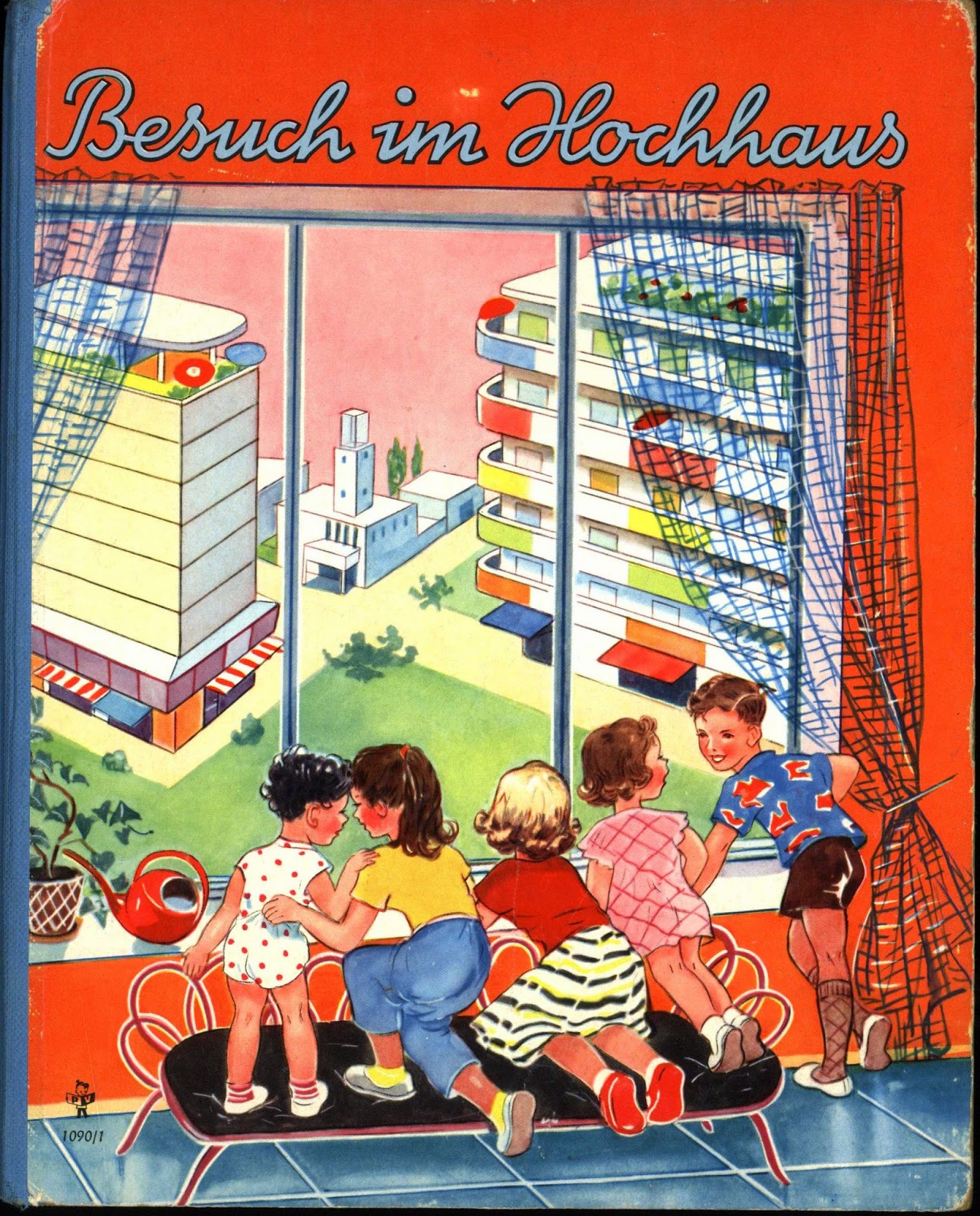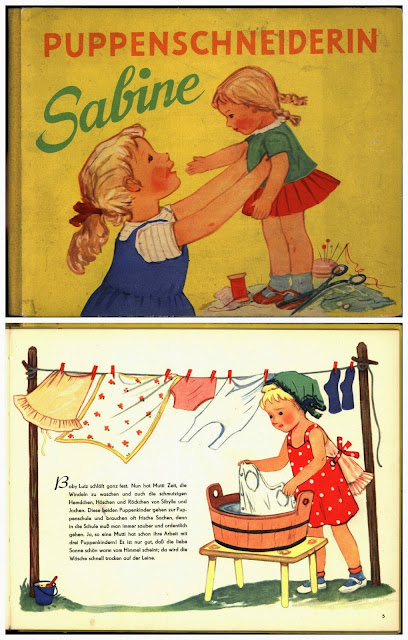Puppenhäuser und Puppenstuben aus Blech sind
in den Nachkriegsjahren in Deutschland die Ausnahme.
Nur wenn mit Wasser gespielt wird,
also im Puppenbad oder in der Puppenküche,
wird das hygienische, abwaschbare
und unzerbrechliche Material Blech lieber eingesetzt als Holz.
Einige Jahre später nahm man dann Kunststoffe und Blech
verschwindet dann nach und nach aus dem Kinderzimmer.
Dolls houses made of tin are rare in post-war Germany.
Only when little girls played with a lot of water,
e.g. in dolls kitchens and bathrooms, or with fire,
e.g. cookers, wood was sometimes replaced by tin.
At the end of the 50s wood and tin were both gradually replaced by plastics.
Diese Stube aus Blech ist also eine Rarität in deutschen Kinderzimmern gewesen.
All die Vorteile einer Blechstube zählt der Hersteller in seiner Anzeige selbst auf.
The advantages of a tin room box are all listed in the ad by the producing firm itself:
foldable
changeable
coloured
washable
hygienic
unbreakable
cheap
Den Nachteil des Materials, Rost, sehen wir SammlerInnen allzu oft.
Aber diese Stube ist wohl trocken gelagert worden
und die Kinder haben nicht zu viel mit Wasser hantiert,
deshalb erstrahlt sie nach 60 Jahren noch in leuchtenden Farben,
auf Blech verblasst die Farbe eben nicht.
The main disadvantage of tin is well-known to us though: rust.
But this room box was stored in a dry cellar
and/or the children did not use much water.
Even after 60 years the colours shine brillantly -
another advantage of tin: the colours do not fade away.
Die Wände sind zurückhaltend lithografiert,
es ist noch genug freier Platz für die eigenen Einrichtungsideen.
Das linke Zimmer ist das Wohnzimmer,
worauf der Kamin auf der trennenden Wand deutlich hinweist.
The walls are not overmuch covered with coloured pictures as in some houses I have seen.
The walls are not overmuch covered with coloured pictures as in some houses I have seen.
There is enough free space to place your own furniture.
The room on the left is the livingroom because of the fireplace.
Warum habe ich die Stube nicht mit den Blechmöbeln vom Hersteller eingerichtet?
In der Anzeige sieht man doch das Wohnzimmer- und das Küchenmöbelprogramm.
Ganz einfach: sie sind noch seltener zu finden als die Stube.
Wenn mal ein Stück bei ebay zu sehen ist,
wird es entweder sehr teuer oder es ist in einem sehr schlechten Zustand.
Ist in einer Auktion sogar einer der Küchen- oder Wohnzimmerfreischwinger enthalten,
erkennt jede/r SammlerIn, dass es ein wertvolles Teil ist
und die Preise steigen noch mehr.
Ich kenne nur wenige Fotos der Originalmöbel
und leider hat kein/e SammlerIn, die ich kenne, Möbel von Monia.
Why did I not furnish the rooms with the original tin sets which are on the photos of the ad?
Very easy to answer: they are as rare as the room box itself and IF you happen to find a piece it costs a small fortune.
Die Küchenwand - die auch eine Krankenhaus- oder Schulzimmerwand sein kann,
wie wir später sehen werden.
The kitchen wall - which could also serve as a hospital or schoolroom wall as we will see next.
The kitchen wall - which could also serve as a hospital or schoolroom wall as we will see next.
Meine Stube ist also mit zeitgenössischen kleinen Holzmöbeln eingerichtet
bis der Zufall und das Glück mir vielleicht mal die Originalmöbel zukommen lässt.
That is why my room box is furnished with a contemporary wooden livingroom and a wooden kitchen.
That is why my room box is furnished with a contemporary wooden livingroom and a wooden kitchen.
Schule - 1954 Monia - school
Hammonia Metallwarenfabrik Friedrich Rost (!!!)
Hamburg

Die Monia Blechpuppenstube ist eine der wenigen deutschen Puppenstuben der Nachkriegszeit,
die aus Blech hergestellt wurden.
Die überwiegende
Mehrzahl aller Puppenhäuser und -stuben in Ost und West sind aus
Holz.
Ich habe den Eindruck, dass Blech-Puppenhäuser
in Großbritannien
und USA sehr viel häufiger zu finden sind.
Meine
Wohnung kann also gemäß der Anzeige von Monia auch eine Arztpraxis
sein,
eingerichtet mit wundervollen Blechmöbeln -
und wenn man die
Mittelwand entfernt, kann sie zum Schule spielen verwendet werden. Das
ist wirklich ein vielseitiges Spielzeug.
Puppenstube mit Bauhausmöbeln, bestehend aus zwei Zimmern,
davon eines als Küche und eines als Wohnzimmer eingerichtet.
Kontext: Die Puppenstube stammt aus Hückelhoven-Baal, 1958.
Kontext: Die Puppenstube stammt aus Hückelhoven-Baal, 1958.
Tin dolls houses were rare in post-war Germany -
I wonder why because there were so many in UK or USA.
The owner's name of the "Hammonia Metal Wares Factory" is a joke though:
The owner's name of the "Hammonia Metal Wares Factory" is a joke though:
translated it means
Friedrich Rust.
According to the ad
above my little dolls apartment can be easily transformed Friedrich Rust.
into a
hospital room or a school room - really quite multifunctional.
Ein
durchdachtes Design:
die Wandillustrationen für Küche und Wohnzimmer
befinden sich alle auf der mittleren Trennwand,
so dass nach der
Entfernung nichts an eine Wohnung erinnert.
A
clever design: the wall illustrations indicating the kitchen
and
livingroom are all on the dividing wall.
When you remove it you get a
plain room which can have many functions.
Auch hier fehlen mir die Blechmöbel und ich habe zeitgenössische Holzmöbel genommen.
Das Rot der Tische passt sehr schön zum Rot der Fenster.
I have several school sets of about that time but none is made of tin. So I chose this wooden furniture with a touch of red which fits quite nicely to the red decoration of the windows.
Das Rot der Tische passt sehr schön zum Rot der Fenster.
I have several school sets of about that time but none is made of tin. So I chose this wooden furniture with a touch of red which fits quite nicely to the red decoration of the windows.
Mehr Blech in meinem Blog - More tin on my blog

>>> 1961 Blechpuppenhaus - Tin Dollhouse
1. Nov. 2016
Schule aus Blech - 1954 Monia - tin school
Vor mehr als einem Jahr habe ich über meine Blechpuppenstube geschrieben,
die mit hölzernen Schulmöbeln eingerichtet war.
Die Mittelwand lässt sich herausnehmen.
More than a year ago I wrote about this tin school
More than a year ago I wrote about this tin school
which was furnished with wooden desks.


MONIA doll flat, designed in modernized form,
Nicht irgendeine Blechschule - nein, die originale Einrichtung von Monia selbst.
The wall in the middle can be removed.
Die neue Einrichtung
The new interior
Blechmöbel
Tin furniture


MONIA doll flat, designed in modernized form,
with reinforced walls
and rounded corners.
The furniture and walls are made of colored,
printed sheet steel.
All parts are washable.
The flat can be transformed
into a school-
and a sick-room by means of supplementary furniture;
comes in printed cardboard box.
1955
1955
Nicht irgendeine Blechschule - nein, die originale Einrichtung von Monia selbst.
Not just any tin furniture but the matching one made by Monia.
Wenn nicht anders vermerkt, sind alle Fotos aus meiner Sammlung
 diePuppenstubensammlerin
diePuppenstubensammlerin
Dieses Werk ist lizenziert unter einer Creative Commons Namensnennung - Nicht kommerziell - Keine Bearbeitungen 4.0 International Lizenz.
 diePuppenstubensammlerin
diePuppenstubensammlerinDieses Werk ist lizenziert unter einer Creative Commons Namensnennung - Nicht kommerziell - Keine Bearbeitungen 4.0 International Lizenz.








































titelbils%20springseil%20reifen.jpg)
bad%20waschen%20z%C3%A4hne.jpg)
schule%20hausaufgaben%20spielen.jpg)
sandkasten%20blecheimer%20spielanzug.jpg)
kinderzimmer%20eisenbahn.jpg)













